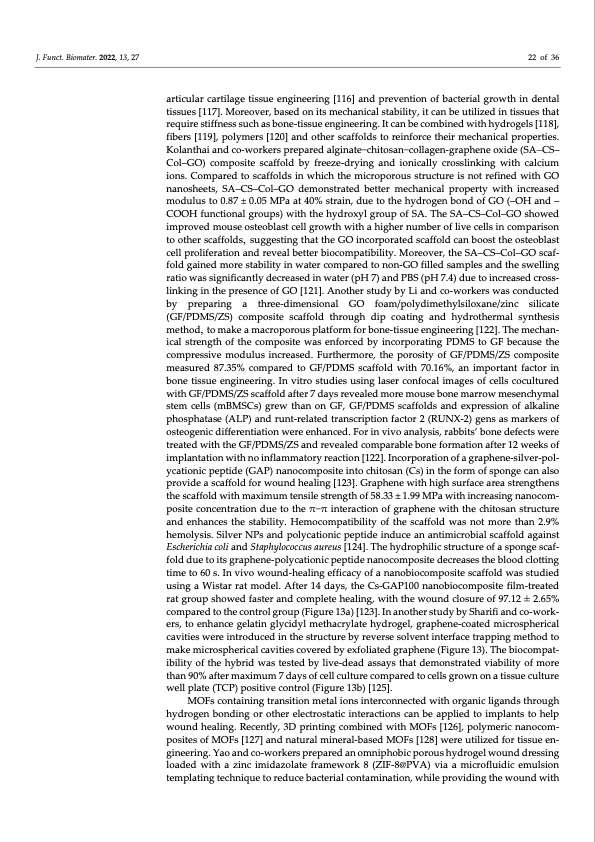
PDF Publication Title:
Text from PDF Page: 022
J. Funct. Biomater. 2022, 13, 27 22 of 36 articular cartilage tissue engineering [116] and prevention of bacterial growth in dental tissues [117]. Moreover, based on its mechanical stability, it can be utilized in tissues that require stiffness such as bone-tissue engineering. It can be combined with hydrogels [118], fibers [119], polymers [120] and other scaffolds to reinforce their mechanical properties. Kolanthai and co-workers prepared alginate−chitosan−collagen-graphene oxide (SA–CS– Col–GO) composite scaffold by freeze-drying and ionically crosslinking with calcium ions. Compared to scaffolds in which the microporous structure is not refined with GO nanosheets, SA–CS–Col–GO demonstrated better mechanical property with increased modulus to 0.87 ± 0.05 MPa at 40% strain, due to the hydrogen bond of GO (–OH and – COOH functional groups) with the hydroxyl group of SA. The SA–CS–Col–GO showed improved mouse osteoblast cell growth with a higher number of live cells in comparison to other scaffolds, suggesting that the GO incorporated scaffold can boost the osteoblast cell proliferation and reveal better biocompatibility. Moreover, the SA–CS–Col–GO scaf- fold gained more stability in water compared to non-GO filled samples and the swelling ratio was significantly decreased in water (pH 7) and PBS (pH 7.4) due to increased cross- linking in the presence of GO [121]. Another study by Li and co-workers was conducted by preparing a three-dimensional GO foam/polydimethylsiloxane/zinc silicate (GF/PDMS/ZS) composite scaffold through dip coating and hydrothermal synthesis method, to make a macroporous platform for bone-tissue engineering [122]. The mechan- ical strength of the composite was enforced by incorporating PDMS to GF because the compressive modulus increased. Furthermore, the porosity of GF/PDMS/ZS composite measured 87.35% compared to GF/PDMS scaffold with 70.16%, an important factor in bone tissue engineering. In vitro studies using laser confocal images of cells cocultured with GF/PDMS/ZS scaffold after 7 days revealed more mouse bone marrow mesenchymal stem cells (mBMSCs) grew than on GF, GF/PDMS scaffolds and expression of alkaline phosphatase (ALP) and runt-related transcription factor 2 (RUNX-2) gens as markers of osteogenic differentiation were enhanced. For in vivo analysis, rabbits’ bone defects were treated with the GF/PDMS/ZS and revealed comparable bone formation after 12 weeks of implantation with no inflammatory reaction [122]. Incorporation of a graphene-silver-pol- ycationic peptide (GAP) nanocomposite into chitosan (Cs) in the form of sponge can also provide a scaffold for wound healing [123]. Graphene with high surface area strengthens the scaffold with maximum tensile strength of 58.33 ± 1.99 MPa with increasing nanocom- posite concentration due to the π−π interaction of graphene with the chitosan structure and enhances the stability. Hemocompatibility of the scaffold was not more than 2.9% hemolysis. Silver NPs and polycationic peptide induce an antimicrobial scaffold against Escherichia coli and Staphylococcus aureus [124]. The hydrophilic structure of a sponge scaf- fold due to its graphene-polycationic peptide nanocomposite decreases the blood clotting time to 60 s. In vivo wound-healing efficacy of a nanobiocomposite scaffold was studied using a Wistar rat model. After 14 days, the Cs-GAP100 nanobiocomposite film-treated rat group showed faster and complete healing, with the wound closure of 97.12 ± 2.65% compared to the control group (Figure 13a) [123]. In another study by Sharifi and co-work- ers, to enhance gelatin glycidyl methacrylate hydrogel, graphene-coated microspherical cavities were introduced in the structure by reverse solvent interface trapping method to make microspherical cavities covered by exfoliated graphene (Figure 13). The biocompat- ibility of the hybrid was tested by live-dead assays that demonstrated viability of more than 90% after maximum 7 days of cell culture compared to cells grown on a tissue culture well plate (TCP) positive control (Figure 13b) [125]. MOFs containing transition metal ions interconnected with organic ligands through hydrogen bonding or other electrostatic interactions can be applied to implants to help wound healing. Recently, 3D printing combined with MOFs [126], polymeric nanocom- posites of MOFs [127] and natural mineral-based MOFs [128] were utilized for tissue en- gineering. Yao and co-workers prepared an omniphobic porous hydrogel wound dressing loaded with a zinc imidazolate framework 8 (ZIF-8@PVA) via a microfluidic emulsion templating technique to reduce bacterial contamination, while providing the wound withPDF Image | Nanomaterials beyond Graphene for Biomedical Applications

PDF Search Title:
Nanomaterials beyond Graphene for Biomedical ApplicationsOriginal File Name Searched:
jfb-13-00027.pdfDIY PDF Search: Google It | Yahoo | Bing
CO2 Organic Rankine Cycle Experimenter Platform The supercritical CO2 phase change system is both a heat pump and organic rankine cycle which can be used for those purposes and as a supercritical extractor for advanced subcritical and supercritical extraction technology. Uses include producing nanoparticles, precious metal CO2 extraction, lithium battery recycling, and other applications... More Info
Heat Pumps CO2 ORC Heat Pump System Platform More Info
| CONTACT TEL: 608-238-6001 Email: greg@infinityturbine.com | RSS | AMP |